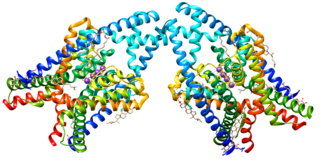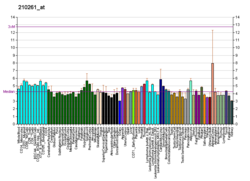
Potassium channels are the most widely distributed type of ion channel found in virtually all organisms. They form potassium-selective pores that span cell membranes. Potassium channels are found in most cell types and control a wide variety of cell functions.

The two-pore-domain or tandem pore domain potassium channels are a family of 15 members that form what is known as leak channels which possess Goldman-Hodgkin-Katz (open) rectification. These channels are regulated by several mechanisms including signaling lipids, oxygen tension, pH, mechanical stretch, and G-proteins. Two-pore-domain potassium channels correspond structurally to a inward-rectifier potassium channel α-subunits. Each inward-rectifier potassium channel α-subunit is composed of two transmembrane α-helices, a pore helix and a potassium ion selectivity filter sequence and assembles into a tetramer forming the complete channel. The two-pore domain potassium channels instead are dimers where each subunit is essentially two α-subunits joined together.

The Kir2.1 inward-rectifier potassium channel is a lipid-gated ion channel encoded by the KCNJ2 gene.

Potassium voltage-gated channel subfamily E member 1 is a protein that in humans is encoded by the KCNE1 gene.

G protein-activated inward rectifier potassium channel 2 is a protein that in humans is encoded by the KCNJ6 gene. Mutation in KCNJ6 gene has been proposed to be the cause of Keppen-Lubinsky Syndrome (KPLBS).

Potassium channel subfamily K member 3 is a protein that in humans is encoded by the KCNK3 gene.

Potassium channel subfamily K member 1 is a protein that in humans is encoded by the KCNK1 gene.

Potassium channel subfamily K member 4 is a protein that in humans is encoded by the KCNK4 gene. KCNK4 protein channels are also called TRAAK channels.

Potassium channel subfamily K member 6 is a protein that in humans is encoded by the KCNK6 gene.

Potassium channel subfamily K member 5 is a protein that in humans is encoded by the KCNK5 gene.

Potassium channel subfamily K member 15 is a protein that in humans is encoded by the KCNK15 gene.

Potassium channel, subfamily K, member 7, also known as KCNK7 or K2P7.1 is a protein which is encoded in humans by the KCNK7 gene. K2P7.1 is a potassium channel containing two pore-forming P domains. Multiple transcript variants encoding different isoforms have been found for this gene.

Potassium channel, subfamily K, member 10, also known as KCNK10 is a human gene. The protein encoded by this gene, K2P10.1, is a potassium channel containing two pore-forming P domains.

Potassium channel, subfamily K, member 12, also known as KCNK12 is a human gene. The protein encoded by this gene, K2P12.1, is a potassium channel containing two pore-forming P domains.

Potassium channel, subfamily K, member 13, also known as KCNK13 is a human gene. The protein encoded by this gene, K2P13.1 is a potassium channel containing two pore-forming P domains.

Potassium channel subfamily K member 16 is a protein that in humans is encoded by the KCNK16 gene. The protein encoded by this gene, K2P16.1, is a potassium channel containing two pore-forming P domains.

Potassium channel subfamily K member 18 (KCNK18), also known as TWIK-related spinal cord potassium channel (TRESK) or K2P18.1 is a protein that in humans is encoded by the KCNK18 gene. K2P18.1 is a potassium channel containing two pore-forming P domains.

Potassium channel blockers are agents which interfere with conduction through potassium channels.
A potassium channel opener is a type of drug which facilitates ion transmission through potassium channels.
Mechanosensitive channels (MSCs), mechanosensitive ion channels or stretch-gated ion channels are membrane proteins capable of responding to mechanical stress over a wide dynamic range of external mechanical stimuli. They are present in the membranes of organisms from the three domains of life: bacteria, archaea, and eukarya. They are the sensors for a number of systems including the senses of touch, hearing and balance, as well as participating in cardiovascular regulation and osmotic homeostasis (e.g. thirst). The channels vary in selectivity for the permeating ions from nonselective between anions and cations in bacteria, to cation selective allowing passage Ca2+, K+ and Na+ in eukaryotes, and highly selective K+ channels in bacteria and eukaryotes.


















